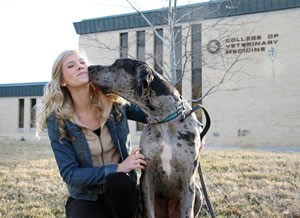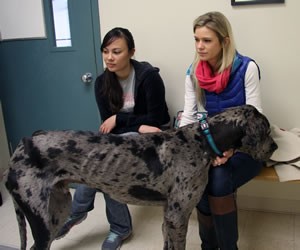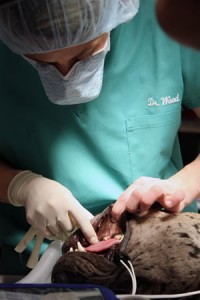
Louie kisses his owner, second-year veterinary student Brittany Hofman, while playing outside the MU College of Veterinary Medicine. “After the surgery he had to relearn how to use his tongue, but he figured it out quickly and shows his gratitude by giving kisses through his ‘tongue hole,’” Hofman said.
Looking at Louie today, it’s hard to imagine he was ever anything but a healthy dog.
But just a few months ago, his future looked grim. The 1-year-old Great Dane had developed bone deposits in his temporomandibular joint. Called craniomandibular osteopathy (CMO), the rare, noncancerous bony proliferation was a serious problem. It fused his jaw shut, causing pain and making it very difficult for him to eat. Unable to afford the costs of further treatment, his owners decided euthanasia was the only option.
Nicole Berlin, a second-year veterinary student at the MU College of Veterinary Medicine, heard about Louie from another student and hoped she could save him. She persuaded his owners to relinquish him. Because she had three dogs already, she couldn’t keep Louie herself, but she decided to foster him until she could find him a permanent home.
When Berlin introduced fellow second-year Brittany Hofman to Louie, it was love at first sight.
“I’ve wanted a Great Dane since I was a little girl,” Hofman said. “You can’t help but fall in love with him.”
Nicknamed “King Louie the Great,” the dog was underweight from malnutrition due to his difficulty eating. His food had to be ground up in a blender and mixed with water so he could more easily suck it up.
Louie’s bony proliferations were advanced, which ruled out more commonly used methods of supportive care. The biggest concern was keeping up with the nutritional requirements of a Great Dane.
CMO more frequently occurs in terrier breeds, such as Westies and Scotties.
“We don’t see it often in general, but especially not in Great Danes,” said Mirae Wood, DVM, assistant teaching professor of small animal surgery.
Hofman and Berlin contacted Derek Fox, DVM, PhD, associate professor of small animal orthopedic surgery. Fox wasn’t optimistic about Louie’s prognosis initially due to the extensiveness of the bony fusion of the two components of the jaw. But the students persisted and persuaded Fox and Wood to consider surgical treatment.
Louie’s doctors used a computed tomography (CT) scan to evaluate Louie’s bony proliferations and determine how best to proceed. The CT scan revealed that the component of the jaw that acts like a hinge had become completely fused with new bone production as part of the disease.

Second-year veterinary students Nicole Berlin and Brittany Hofman wait with Louie before his surgery in December. The Great Dane was underweight because his fused jaw made eating difficult. Since his surgery he has gained 40 pounds.
Removal of this excessive bone would allow mobility of the jaw, in theory, but would be very risky and invasive. Therefore Wood and Fox considered alternative techniques and decided to approach the problem from a different angle. Instead of removing the bony fusion, they decided to widen the opening of the front of his mouth by removing a portion of the jaw that makes up his chin. This wider opening would allow Louie to extend his tongue out of his mouth and, in time, learn to funnel food and water using his lips and tongue. Although he still would not be able to open his mouth, at least he would be able to eat and drink unassisted if he could adapt to the new method after the surgery.
The case was unique, Wood said, and only one similar surgery with a successful outcome has been documented. Neither Fox nor Wood had ever attempted this in a dog with his condition.
During the surgery, Louie’s doctors also added a feeding tube to his stomach to help him get the nutrition he desperately needed. Amazingly, Wood said, Louie didn’t have any complications from the surgery. He was eating the next day, and his feeding tube was removed in less than three weeks.
Besides the lifesaving care Louie received, the experience provided an educational opportunity for Berlin and Hofman. The students got to watch the surgery, which offered them a glimpse at the clinical instruction they will begin in their third year and made them less nervous about Louie’s fate, they said.
“While we were in there I felt at ease because I knew he was in great hands,” Hofman said. “I was able to see the care and precision of the doctors. It was as if they were treating their own pet.”
Since his surgery in late December, Louie has gained 40 pounds.

Dr. Mirae Wood, assistant teaching professor of small animal surgery, examines Louie’s mouth before beginning surgery. Louie’s veterinarians decided to remove a portion of his jaw to widen the opening of the front of his mouth. This allows him to eat and drink by funneling food and water with his lips and tongue.
“After the surgery he had to relearn how to use his tongue, but he figured it out quickly and shows his gratitude by giving kisses through his ‘tongue hole,’” Hofman said. “He had a quick and smooth recovery and acts like any normal 1-year-old Great Dane now. Louie loves treats, toys and following his mom around the house. He is extremely loyal, loves to cuddle and despite his size often thinks he’s a lap dog.”
Louie’s care was paid for by the Silent Partners Fund. The fund was established to assist pets that have a good chance of recovery, but whose owners lack the financial resources to pay for the care needed to save their animals’ lives.
“From this experience I learned how truly blessed I am to be a part of such an extraordinary institution,” Hofman said. “The people at the University of Missouri set it apart from other schools. They care immensely for the animals that they treat. I also learned that as veterinarians we cannot change every animal in the world, but we can change the world for an animal. I’m forever grateful to everyone who gave Louie a second chance at life.”
For information on ways to support the Silent Partners Fund or the Small Animal Surgical Service, please contact the Advancement office at 888-850-2357.



